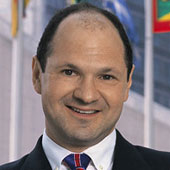Citibank’s Marketing Metamorphosis
In post-bubble America, how has Citibank set the new standard for marketing financial services?
March 15, 2001
Back in the late 1980s, Citibank ran a series of catchy ads that declared: “The Citi never sleeps.” It was a powerful slogan that indicated the company’s globe-spanning, tireless efforts on behalf of clients.
But, in 1990, Citibank almost went “to sleep with the fishes,” as they say in some of New York City’s neighborhoods. In other words, it nearly went bust. Citibank’s predicament was one of the main reasons why the Federal Reserve kept its interest rates very low until 1994: to let troubled U.S. banks strengthen their balance sheets. In the process, it laid the groundwork for a spectacular U.S. economic boom in the second half of the decade.
Now, in 2001, Citibank’s new ad campaign centers around the slogan “Live richly.” This suggests that money and worldly success are overrated, while the richness of life comes from other things.
Of course, Citibank has had a long tradition of paying tribute to fashion. In the mid-1970s, it was one of the first major U.S. banks to get on with the times and shed its straightlaced image. It junked its fuddy-duddy name, First National City Bank, and adopted an informal, italicized logo. Today, it looks to be the first in the established financial services industry to adapt to the post-bubble mood of hangover in America.
For much of the 1990s, Citibank was not really heard from, at least as far as advertising was concerned. Then, in 1998, Citibank merged with Sandy Weill’s $420 billion Traveler’s Group. Together, they formed Citigroup — Citibank’s parent corporation and one of the world’s premier integrated financial services companies.
The bank thus became a high profile gear in the financial services cross-selling machine envisioned by Citigroup’s creators. Nevertheless, this banking behemoth has been strangely absent from the public’s view. With its new ad campaign, Citibank seems to be trying to change all that.
Citibank has hired a new advertising agency to come up with a series of ads and TV commercials. But strangely, the ads portray a less than congruous image for a bank that is held in such high regard.
One of the first commercials of the “new Citibank” ran during recent National Football League playoff games. It featured a musician playing a mouth organ and appeared to have been filmed with a hand-held camcorder — like something out of the popular low-budget horror movie “The Blair Witch Project.”
The caption? “Nobody has ever written a song about a stock market index. Live richly.”
The ad pinpoints the dilemma in selling financial services in post-stock market bubble America. People are disillusioned with financial markets. Wall Street has dominated the headlines for more than five years. CNBC, the TV channel that covered the stock market for the masses, was always on in all sorts of strange venues, from airports to sports clubs and singles’ bars.
But the stock market, which was meant to make all Americans rich, has proved to be a bit of fool’s gold. It made people feel wealthy for a time, encouraging consumers to spend money with wild abandon, and then promptly turned huge paper profits into real losses. The average American household is now saddled with $10,000 in credit card debt even as companies have started laying off staffs by the thousand.
When people become poor, it is the best time to complain about the evils of materialism and filthy lucre. And this is the vein which Citibank commercials are trying to tap into. Downtown Manhattan has been plastered with ads harping on this theme:
“People make money. Not the other way around.”
“Don’t wait until somebody says ‘Your money or your life’ to remember that they are two different things.”
“The one who dies with the most toys is still dead.”
Billboards displaying Citibank’s implicit criticism of the overly ambitious can even be found in some of New York’s poorest boroughs. “The bank for the upwardly normal”, proclaims a billboard in a poor, mostly Hispanic section of the Bronx.
In addition to street ads and TV commercials, Citibank ads have been running in selected fashionable magazines. Like Vanity Fair, the magazine for the unabashedly wealthy — or at least those who admire them. The Citibank ad is buried among dozens of pages of top designer ads for Gucci, Dolce & Gabbana and Versace.
The ad is amusing, given the context. It shows a wholesome yuppie couple unloading a trunkful of fancy shopping bags from a yellow cab. “Just because you can doesn’t mean you should,” declares the caption, offering “Credit cards with features you need to find balance and spend wisely.”
Of course, the idea that banking is too staid is probably as old as banking itself. Older generations of Americans who grew up on the Walt Disney classic, “Mary Poppins,” know that bankers need to go fly a kite to loosen up. What is new is that it is no longer Hollywood, or Bohemian artists, who are poking fun at banking. It is Citibank, the largest U.S. bank, that is leading the way.
“You can skip your morning coffee for a year and make an extra mortgage payment,” proclaims another of Citibank’s ads. “But you will be grumpy.”
The strategy is not without risk. Citibank is now part of a conglomerate that includes Solomon Smith Barney, a bulge-bracket investment bank — and insurance underwriter Travelers. In fact, Travelers’ trademark red umbrella has become part of Citibank’s corporate logo, brightly adorning its new ads.
Will Americans who want to live richly all huddle together under that umbrella on a rainy day?
Read previous
The IMF and Globalization
March 14, 2001
